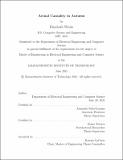| dc.contributor.advisor | Solar-Lezama, Armando | |
| dc.contributor.advisor | Tavares, Zenna | |
| dc.contributor.author | Weeks, Elizabeth | |
| dc.date.accessioned | 2022-01-14T15:01:17Z | |
| dc.date.available | 2022-01-14T15:01:17Z | |
| dc.date.issued | 2021-06 | |
| dc.date.submitted | 2021-06-17T20:14:46.919Z | |
| dc.identifier.uri | https://hdl.handle.net/1721.1/139281 | |
| dc.description.abstract | Actual causality is determining causation for specific events. This includes questions such as: did the pasta on the stove cause the fire alarm to go off or did the power outage cause the lights to turn off? Another example follows: If Suzie throws a rock at a bottle and later Billy throws a rock at the same bottle, a question of actual causality is, did Suzie throwing a rock cause the bottle to break? One common method to answer questions of actual causality is to evaluate the situation if the first event did not occur. This is known as a counterfactual approach. If Suzie had not thrown the rock, then the bottle would still have broken. This means that the counterfactual approach does not lead to the same conclusion that most humans arrive at. In this paper, we define a new method for questions of actual causality, which we call the causal path method. To evaluate this method, we compare it to the counterfactual approach and the expectations of humans from related work. To test this method, we use Autumn models. Autumn is a programming language for expressing causal probabilistic models that provides the infrastructure to express real-world mechanisms in code. In Autumn we are able to model and test the Billy and Suzie rock example. After evaluating the method on these Autumn models, we explore further applications for the new causal path method. | |
| dc.publisher | Massachusetts Institute of Technology | |
| dc.rights | In Copyright - Educational Use Permitted | |
| dc.rights | Copyright MIT | |
| dc.rights.uri | http://rightsstatements.org/page/InC-EDU/1.0/ | |
| dc.title | Actual Causality in Autumn | |
| dc.type | Thesis | |
| dc.description.degree | M.Eng. | |
| dc.contributor.department | Massachusetts Institute of Technology. Department of Electrical Engineering and Computer Science | |
| mit.thesis.degree | Master | |
| thesis.degree.name | Master of Engineering in Electrical Engineering and Computer Science | |
